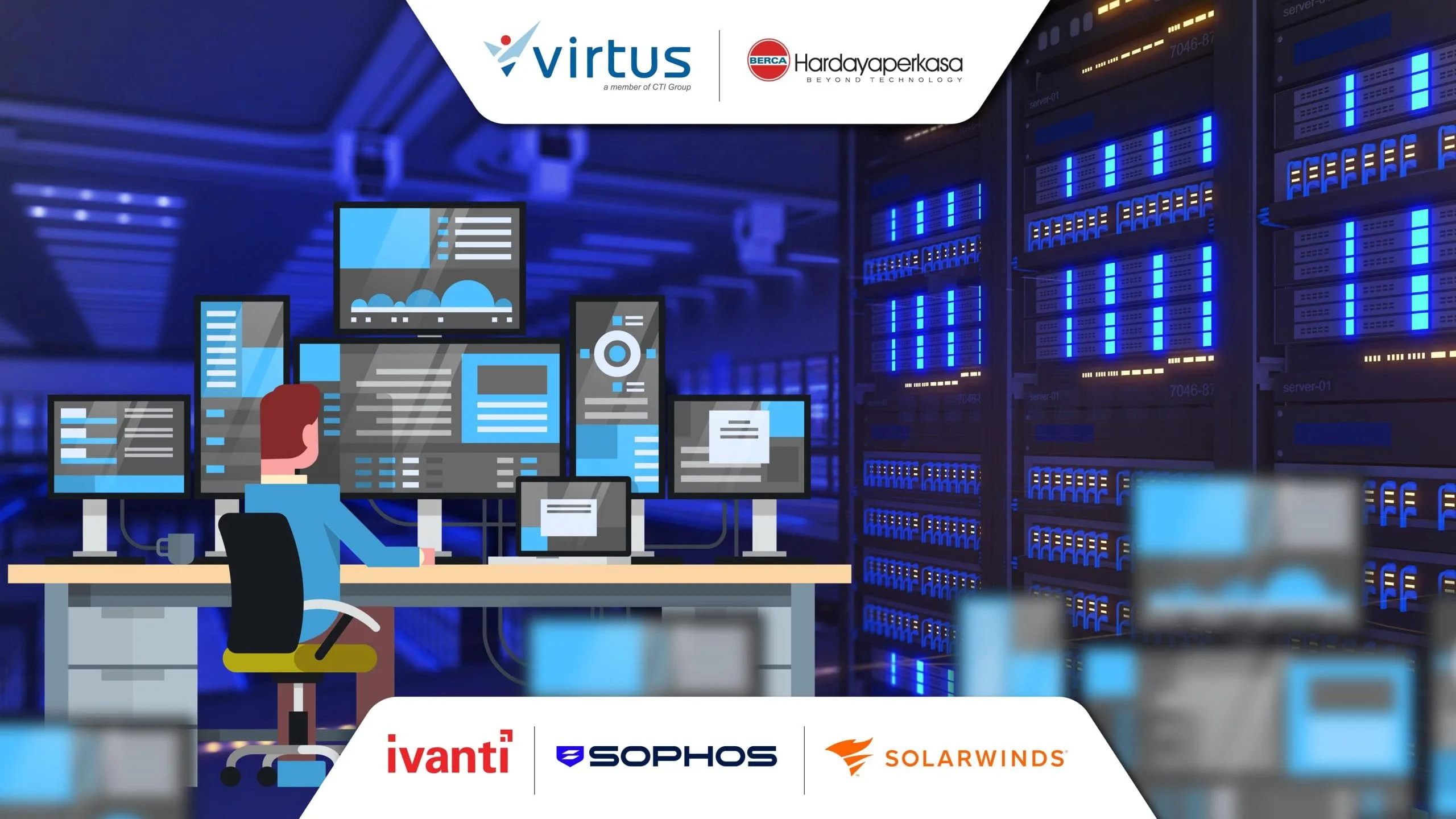In today’s threat landscape, cybersecurity monitoring has become one of the most effective strategies to counter increasingly sophisticated, coordinated, and stealthy cyberattacks. Just imagine—what would happen if your critical business data were compromised, and operations came to a halt for days, as experienced by several organizations, including major financial institutions? Beyond financial losses, such incidents significantly damage brand reputation and erode customer trust across industries.
Security is no longer just about response and protection. “Security doesn’t stop at protection – it starts with visibility, grows with patching, and scales with proactive monitoring.” That’s why an integrated security approach—starting from infrastructure visibility, patch management, and threat protection to continuous monitoring—is essential for building long-term cyber resilience.
Without this end-to-end cycle, organizations face the risk of undetected attacks that can escalate into major disruptions. Modern cybersecurity is no longer about defense alone—it’s about creating adaptive, reliable, and vigilant systems that anticipate and neutralize risks before they strike.
What is Cybersecurity Monitoring?
Cybersecurity monitoring is the continuous process of overseeing an organization’s systems, networks, applications, and data to detect, analyze, and respond to suspicious activity or cybersecurity threats in real time. This process is typically executed through integrated systems leveraging technologies such as Security Information and Event Management (SIEM), Endpoint Detection and Response (EDR), or other security platforms capable of collecting logs, analyzing anomalies, and sending automated alerts when potential incidents are detected.
This monitoring covers various elements, including malware detection, access policy violations, unusual user behavior, and external hacking attempts. In essence, cybersecurity monitoring functions as an early warning system, helping security teams act swiftly before threats escalate into serious incidents that can harm the organization
Why Cybersecurity Monitoring is Crucial for Organization?

In today’s digital age, data has become one of the most valuable business assets, and with the increasing prevalence of data theft for malicious use or resale, cybersecurity monitoring has become essential for maintaining business continuity and protecting organizational reputation. Without active and continuous monitoring, cyber threats like ransomware, phishing, or insider attacks can go undetected.
The consequences can include financial losses, legal ramifications, and a decline in public trust. Moreover, cybersecurity monitoring is often a regulatory requirement under frameworks such as GDPR, HIPAA, or ISO 27001, which demand proactive measures to ensure data integrity and security.
Real-time monitoring enables organizations to detect anomalies more quickly, reduce mean time to detect/respond (MTTD/MTTR), and strengthen overall security posture. In many cases, early detection is the key to preventing the severe consequences of escalating cyberattacks on business operations.
How Cybersecurity Monitoring Works?
Cybersecurity monitoring is a continuous process aimed at detecting, analyzing, and responding to cybersecurity threats in real time. It begins with the collection of log data and network activity from various sources such as firewalls, endpoints, servers, applications, and cloud environments.
The gathered data is then consolidated into a security platform—such as a SIEM system—to be analyzed and automatically correlated to identify anomalies or potential threats. Using rule-based analysis and AI-driven behavioral insights, the system detects suspicious patterns, such as unauthorized access, data exfiltration, or connections to command-and-control servers.
If a threat is identified, automated alerts are sent to the security team for follow-up action. Some systems are equipped with automated response features that can immediately block malicious activity or isolate infected devices from the main network.
Beyond threat detection, cybersecurity monitoring also plays a critical role in compliance audits, incident investigations, and system remediation. With 24/7 operations, it provides organizations with full visibility into their security posture, enables faster incident response, and reduces the risk of data breaches and operational downtime.
How to Implement Cybersecurity Monitoring?

There are several stages in implementing cybersecurity monitoring into your company’s IT infrastructure. Here are the steps:
1. Patch First, Break Never: Building a Strong Cyber Resilience Foundation
Before detecting and monitoring threats, the most critical first step in implementing cybersecurity monitoring is ensuring the system has no vulnerabilities from the outset. This is where patch management plays a vital role.
In fact, many cyberattacks occur not because of sophisticated new techniques, but because of the exploitation of known vulnerabilities for which patches are already available but haven’t been applied. The principle of “Patch First, Break Never” emphasizes the importance of consistently updating systems and applications to build a strong security foundation without disrupting operations.
Recent case studies have shown that Ivanti Patch Management & Ticketing (IDSM) can automatically remediate critical vulnerabilities before they are exploited by cybercriminals. With automated patching for operating systems and third-party applications, centralized deployment, and patch rollback features to mitigate operational risks, Ivanti accelerates the response cycle to zero-day threats. Patch management, application control configuration, and ticketing will become built-in solutions provided by Ivanti to help organizations identify vulnerabilities more quickly across their systems.
2. Layered Protection: Unified Endpoint and Network Security
Once a solid cyber resilience foundation is established, the second step in cybersecurity monitoring is implementing unified, layered protection across endpoints, emails, applications, and networks. A Unified Threat Protection (UTP) approach is essential to ensure there are no blind spots—whether it’s unscanned endpoint files, undetected phishing emails, or overlooked network vulnerabilities.
Sophos Endpoint Security delivers a unified defense by integrating Sophos Firewall and Sophos Antivirus. Sophos Firewall supports deep packet inspection, sandboxing, and a zero trust architecture. Both solutions are connected in an intelligent ecosystem that can detect coordinated threats, trigger automated responses, and significantly reduce false positives.
3. Know Before It Fails: Proactive Infrastructure Monitoring Infrastruktur
The third stage in cybersecurity monitoring implementation is early detection—proactively monitoring infrastructure before disruptions occur. Early warnings are a form of predictive monitoring that can effectively prevent system failures from impacting operations.
SolarWinds offers four integrated monitoring solutions tailored to meet modern IT operations and security needs. SolarWinds Observability helps organizations monitor network performance using NPM (Network Performance Monitoring), providing real-time insights into availability, latency, and bottlenecks on critical network devices.
The Network Configuration Manager (NCM) enables IT teams to centrally push configurations to firewalls and other network devices, including creating configuration templates for faster, more consistent network management free of human error. Beyond network monitoring, Server Configuration Monitor (SCM) helps proactively track server configurations and performance to detect potential service disruptions early.
On the security side, Security Event Manager (SEM) acts as a Security Information and Event Management (SIEM)solution, aggregating, managing, and analyzing security logs from multiple sources. This provides deep visibility to detect anomalies, speed up incident investigations, and support regulatory compliance.
4. Unified Visibility: An End-to-End Strategy from Patch to Monitoring
This fourth stage is a critical component in building a proactive and resilient cybersecurity system. By adopting an ideal workflow—Discover → Patch → Protect → Monitor—businesses can proactively close security gaps while establishing an integrated framework for real-time threat detection and response.
This approach delivers strategic benefits, such as complete visibility across the IT infrastructure, consistency in security policy enforcement, and operational efficiency through the integration of previously fragmented security processes. When patching and monitoring visibility are executed in a single ecosystem, organizations can prevent system conflicts, accelerate anomaly detection, and streamline security reporting.
To unify these approaches, start by integrating monitoring tools with existing patch management and endpoint protection platforms. Then, create a centralized dashboard that consolidates threat data, patch status, and security alerts into a single view—enabling faster and more accurate layered security operations.
Get Cybersecurity Monitoring Solution Only at Virtus
Virtus Technology Indonesia (VTI) as part of CTI Group, offers comprehensive and proactive cybersecurity monitoring solutions—because there is no such thing as perfect security without full visibility and a proactive mindset.
Make sure you’ve built a strong cyber resilience foundation to prevent sophisticated, structured, and often hidden threats that are difficult to detect. Are you confident that your systems are fully protected, visible, and easily monitored?
If you’re unsure whether your business has established a proactive and sustainable cyber resilience strategy, consult with the Virtus team or contact the Berca Hadayaperkasa team to begin your tailored implementation of cybersecurity monitoring solutions.
Author: Ervina Anggraini – CTI Group Content Writer

